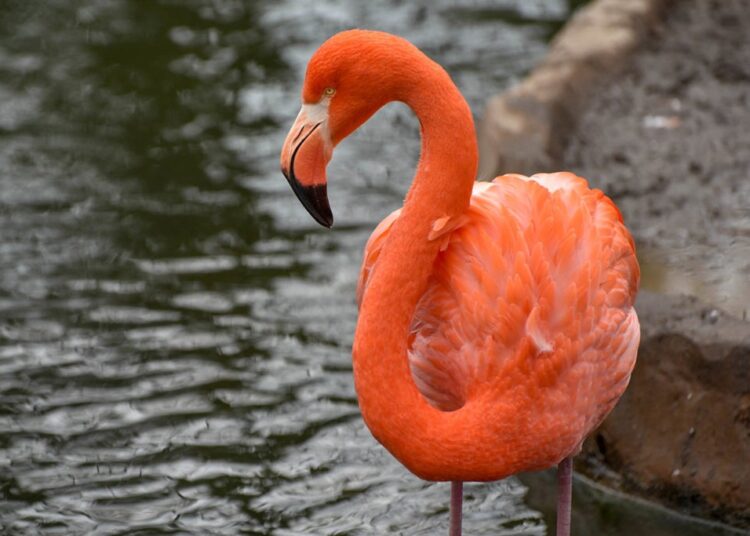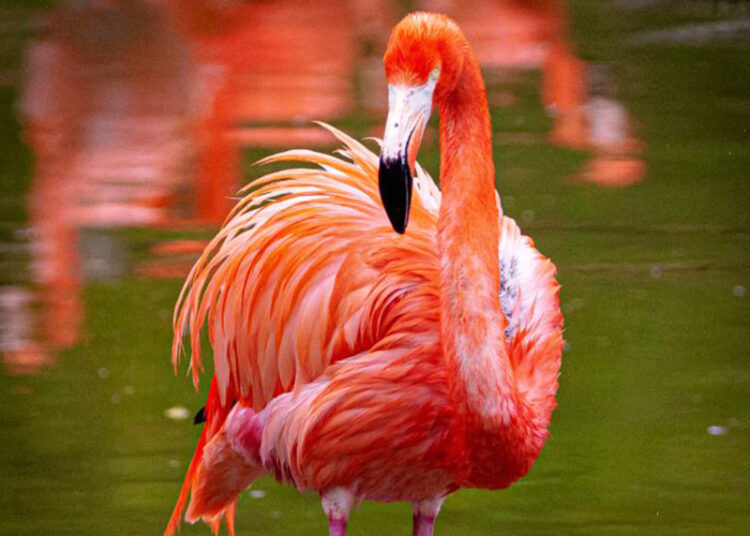Flamingos: elegant and graceful. We are captivated by their marvelous look and behavior. These birds have a vibrant pink plumage and long, slender legs with curved bills. They live in both freshwater and saltwater habitats, creating a wonderful sight.
The beauty of flamingos does not stop at their appearance. They form strong social bonds with each other. They live in large colonies, made up of thousands of individuals. They perform courtship rituals and vocalizations. Plus, they even nest close together to protect their young.
Did you know flamingos have a special filtering system in their bills? It acts as a sieve, helping them catch tiny brine shrimp. These shrimp contribute to their pink coloration.
Flamingos have fascinated humankind for centuries. Ancient Egyptians depicted them in art, associating them with the sun’s reflection on water. Aztecs and Incas treasured flamingo feathers for headdresses and attire. Even today, we are still inspired by their cultural significance.
The physical characteristics of Flamingos
| Characteristic | Description |
|---|---|
| Species | Flamingos belong to the family Phoenicopteridae, and there are six different species. |
| Size | Flamingos vary in size depending on the species, but they typically range from 3 to 5 feet (0.9 to 1.5 meters) in height. |
| Color | Flamingos are known for their vibrant pink or reddish plumage, which comes from their diet rich in carotenoid pigments. |
| Legs | They have long, slender legs that are often pink or reddish, and webbed feet adapted for wading in water. |
| Neck | Flamingos have long, graceful necks that they use for feeding by sweeping their heads underwater. |
| Bill | They have distinctive, downward-curving bills with a filter-feeding structure that allows them to trap small aquatic organisms. |
| Wings | Flamingos have large wings with black flight feathers. They are strong flyers despite their size. |
| Habitat | They are often found in shallow, brackish or alkaline lakes, lagoons, and estuaries with abundant food sources. |
Fact 1: Flamingos are social birds
Flamingos, these amazing creatures, are renowned for their sociable nature. They live in large groups, making a sense of friendship among them. These colonies can reach thousands of members and provide safety from predators. They bond through activities like preening, eating, and even dancing. Communication is vital and they use vocalizations and body movements to talk and organize collective activities.
Both parents share duties such as hatching eggs and caring for chicks. Plus, their formations while flying or resting look synchronized, which reinforces their unity. Also, flamingos have unique feeding habits, using their bills to filter-feed on small organisms from muddy waters.
If you get a chance, watch how they interact with each other – it’s an incredible sight!
Fact 2: Flamingos get their pink color from their diet

Flamingos’ mesmerizing pink color is something to behold! But what is the secret to these birds’ vibrant hue? Let us uncover the world of flamingos and discover how they get their pretty color.
- Flamingos consume algae, crustaceans, and small fish, which contain pigment molecules called carotenoids.
- The carotenoids are absorbed by the digestive system and travel through the bloodstream.
- These molecules accumulate in the feathers and skin, resulting in the flamingos’ pink color.
- The more carotenoids they consume, the deeper and more intense the pink becomes.
Interestingly, not all flamingos are born pink. Young flamingos have gray or white feathers until they get enough carotenoids from their diet. Then, their feathers gradually turn pink as they mature.
Pro Tip: To witness the beauty of flamingos in their full glory, visit saltwater habitats such as lagoons or salt pans.
Fact 3: Flamingos can stand on one leg for hours
Flamingos’ unique ability to balance on one leg for hours is incredibly graceful and stable. This behaviour helps them in a few ways. Firstly, it conserves energy and minimizes heat loss in wetland habitats. Secondly, it helps them regulate their body temperature by keeping one leg warm and the other cool. Lastly, it helps them hide from predators.
Despite all this, researchers still don’t know the mechanisms that allow flamingos to maintain their balance and remain fatigue-free. To protect their populations, we must focus on preserving wetlands and controlling pollution. This way, these elegant birds can thrive safely.
Fact 4: Flamingos can fly long distances
Flamingos are renowned for their colorful plumage and elegant movements. But they can also soar through the skies with remarkable skill! These birds have long wings, enabling them to travel great distances in a single flight. They often fly in large flocks to share the workload and take turns leading the way. Plus, their slender bodies and specialized flight muscles help them maintain fast speeds in the air. When in flight, flamingos often form a V-shape to reduce wind resistance and conserve energy.
However, there is one thing that sets flamingos apart from other migratory birds. They migrate whenever they sense the need to do so, regardless of season or time of year. This is a testament to their adaptability and flexibility.
In 2014, a group of greater flamingos made an incredible journey of 3,500 kilometers from Kazakhstan to Delhi! This shows how far these majestic birds can fly with grace and endurance.
Fact 5: Flamingos build large nests to lay eggs
Flamingos, renowned for their bright pink feathers, are an amazing sight! They also have fascinating nesting behavior. They build huge nests using mud and twigs, providing a safe place for their eggs. The nests are usually near water, offering protection from predators and easy access to food.
Flamingos work together to make their nests stronger. This reflects their bond and the importance of working together. The nesting site is also used as a feeding ground for flamingos, so they can feed their young and themselves at the same time.
Furthermore, flamingos demonstrate impressive parenting skills. Both parents take turns incubating the eggs until they hatch. This aids the survival of their offspring.
Flamingo nests are typically built in colonies, with thousands or even tens of thousands of birds. This communal nature protects against egg thieves and creates a pleasant social setting.
Remember, all the information here is sourced from National Geographic’s publication on ‘The Wonders of Flamingo Behavior’. So, next time you see a pink spectacle near a large nest, take a moment to admire the incredible nesting prowess of these graceful birds.
12 Amazing Facts About the Shoebill Stork: Size, Diet
50 Cutest Animals To Melt Your Heart like Butter
Fact 6: Flamingos have a unique feeding behavior
Flamingos have a unique feeding behavior that sets them apart. They scoop up water and mud with their curved bills, then tilt their heads upside down to filter food particles from the water. The bill acts as a filter, preventing large debris from entering. Plus, their tongue is like a squeegee, pushing out water while keeping small prey.
These birds are adapted for their habitat too. Long legs let them wade into deep water and webbed feet help them move through muddy areas.
A remarkable story happened at the San Diego Zoo. A flamingo ate a large fish whole – something they usually don’t do! This showed how flexible their feeding behavior is, as they can eat a wide range of food sources.
Fact 7: Flamingos are excellent swimmers

Flamingos are quite remarkable swimmers! Their special anatomy and behaviours make them super agile in the water. They have webbed feet which help them power through the water quickly and easily. Plus, their long, thin legs help them paddle and kick in harmony.
Unlike other birds, flamingos have waterproof feathers which keep them buoyant, and they can filter feed in the water too! Moreover, flamingos can even dive underwater when looking for food or when they feel threatened.
Not only do flamingos swim great, but they can thrive in various aquatic environments – from shallow salt pans to deep lakes. Ancient Egyptians were inspired by flamingos’ swimming proficiency, and believed they had divine qualities and were symbols of beauty and elegance.
Fact 8: Flamingos are found in various parts of the world
Flamingos – elegant and captivating – can be found across the world. Six species of these vibrant birds inhabit Africa. The Greater Flamingo is spotted in Europe, Asia, Africa, and the Americas. In North America, flamingos can be seen in Florida and Mexico. Chile and Argentina are popular places to see flamingos in South America.
These birds are remarkable for their pink plumage, which comes from their diet of algae and crustaceans. They also form large flocks, with some flocks reaching thousands of individuals during breeding seasons.
Dr. Juan Carlos Torres-Mura from Austral University of Chile discovered that flamingos can detect rain up to 500 kilometers away, so they can migrate according to changing weather.
Flamingos’ unique traits and global presence make them captivating. Their striking appearance and intriguing behaviors show us the beauty of nature.
Conclusion: Fascinating facts about flamingos
Flamingos are truly remarkable! They have tons of unique traits. For instance, they can stand on one leg for extended periods, which is a mystery to scientists. This may help them save energy and keep warm. Plus, they feed by dipping their heads upside down in the water and filtering out tiny organisms with comb-like bills. Their pink plumage comes from their shrimp and algae diet.
Flamingos are social creatures too, living in large colonies – some with thousands of birds! They communicate with vocalizations and synchronized displays. Also, they form strong pair bonds and engage in elaborate courtship rituals. Both parents share incubation of the egg in mud or clay nests.
Flamingos also migrate long distances – some over 600 miles – in search of suitable breeding grounds. This highlights their resilience and adaptability.
The information in this article comes from research by ornithologists at the Cornell Lab of Ornithology, a top institution for avian studies.
Frequently Asked Questions
Q: What is the average lifespan of a flamingo?
A: Flamingos have an average lifespan of 20 to 30 years in the wild.
Q: How do flamingos get their pink color?
A: Flamingos get their pink color from the food they eat. Their diet consists of brine shrimp and blue-green algae, which contain pigments that turn their feathers pink.
Q: Can flamingos fly?
A: Yes, flamingos can fly. They have long wings, and when in flight, their wingspan can reach up to 5 feet. However, they are more comfortable in water and prefer to fly only when necessary.
Q: Why do flamingos stand on one leg?
A: Flamingos often stand on one leg to conserve body heat. By tucking one leg up close to their body, they reduce the amount of heat lost through their long, thin legs.
Q: How do flamingos build their nests?
A: Flamingos build their nests using mud and other available materials. They create cone-shaped mounds that can be up to 1 foot high. These nests are usually built in shallow water to protect them from predators.
Q: Do flamingos live in flocks?
A: Yes, flamingos are highly social birds and live in large flocks. These flocks can range from a few dozen to thousands of individuals. Living in flocks provides protection against predators and allows them to find food more easily.
The scientific classification of Flamingos
| Taxonomic Rank | Classification |
|---|---|
| Kingdom | Animalia (Animals) |
| Phylum | Chordata (Chordates) |
| Class | Aves (Birds) |
| Order | Phoenicopteriformes (Flamingos) |
| Family | Phoenicopteridae (Flamingos) |
How to Say “Flamingos” in different Languages:-
- Spanish: “Flamencos” (pronounced flah-men-kohs)
- French: “Flamants” (pronounced flah-mahn)
- German: “Flamingos” (pronounced flah-meen-gohs)
- Italian: “Fenicotteri” (pronounced feh-nee-koh-teh-ree)
- Portuguese: “Flamingos” (pronounced flah-meen-gohs)
- Russian: “Фламинго” (pronounced fla-min-goh)
- Japanese: “フラミンゴ” (pronounced furah-min-go)
- Chinese (Mandarin): “火烈鸟” (pronounced huǒ liè niǎo)
- Arabic: “الفلامنغو” (pronounced al-fa-lah-man-gho)
- Swahili: “Flamingo” (pronounced flah-meen-goh)








